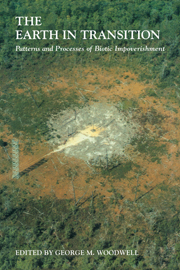Book contents
- Frontmatter
- Contents
- Preface
- Acknowledgments
- List of Contributors
- Part I Global Change and the Patterns of Impoverishment
- 1 The Earth under Stress: A Transition to Climatic Instability Raises Questions about Patterns of Impoverishment
- 2 The Experimental Impoverishment of Natural Communities: Effects of Ionizing Radiation on Plant Communities, 1961 – 1976
- 3 Air Pollution and Temperate Forests: Creeping Degradation
- 4 The Long-Term Effects of Air Pollutants on Lichen Communities in Europe and North America
- 5 Biotic Impoverishment in Northern Peatlands
- 6 Climatic Change and the Survival of Forest Species
- 7 The Atmosphere and the Future of the Biosphere: Points of Interactive Disturbance
- Part II Chronic Disturbance and Natural Ecosystems: Forests
- Part III Chronic Disturbance and Natural Ecosystems: Woodlands, Grasslands, and Tundra
- Part IV Chronic Disturbance and Natural Ecosystems: Aquatic and Emergent Ecosystems
- Part V Conclusion: Steps toward a World That Runs Itself
- Name Index
- Subject Index
5 - Biotic Impoverishment in Northern Peatlands
Published online by Cambridge University Press: 24 November 2009
- Frontmatter
- Contents
- Preface
- Acknowledgments
- List of Contributors
- Part I Global Change and the Patterns of Impoverishment
- 1 The Earth under Stress: A Transition to Climatic Instability Raises Questions about Patterns of Impoverishment
- 2 The Experimental Impoverishment of Natural Communities: Effects of Ionizing Radiation on Plant Communities, 1961 – 1976
- 3 Air Pollution and Temperate Forests: Creeping Degradation
- 4 The Long-Term Effects of Air Pollutants on Lichen Communities in Europe and North America
- 5 Biotic Impoverishment in Northern Peatlands
- 6 Climatic Change and the Survival of Forest Species
- 7 The Atmosphere and the Future of the Biosphere: Points of Interactive Disturbance
- Part II Chronic Disturbance and Natural Ecosystems: Forests
- Part III Chronic Disturbance and Natural Ecosystems: Woodlands, Grasslands, and Tundra
- Part IV Chronic Disturbance and Natural Ecosystems: Aquatic and Emergent Ecosystems
- Part V Conclusion: Steps toward a World That Runs Itself
- Name Index
- Subject Index
Summary
Editor's Note: Bogs and peat and acid waters are commonly thought to be of the higher, cooler latitudes, not tropical. But peatlands and acid waters occur around the world. The traveler in the Amazon Basin, for instance, until recently restricted to its rivers, found a new world in the transition from the silt-laden water of the main stem of the Amazon or the Solimoes to the black, acid water of the Rio Negro. The traveler is blessed there with an abrupt relief from insect pests: I have slept comfortably, without screens or mosquito netting, 60 miles above Manaus in the magnificent riverine bog-swamp known by the lyrically liquid name Anavilhanas. The black water is the drainage from bog soils, extensive in that part of the basin, and supports an extraordinary fauna of herbivorous and seed-eating fishes that graze in the rich varzea forests, flooded annually to a depth of 30–50 feet in many places.
The fact is that peatlands are widespread around the world, apparently the product of a biotically caused acidification of moist habitats that are low in nutrients. Their plant and animal communities are at once impoverished by comparison with other sites that are rich in nutrients and less acid, and yet the bogs are rich in fascinating endemics such as the seed-eating fishes of the Rio Negro. The habitat is ancient, common, widespread, important, still evolving, sometimes thought to be the product of a regressive series of changes that reduces tree growth and leads otherwise to impoverishment.
- Type
- Chapter
- Information
- The Earth in TransitionPatterns and Processes of Biotic Impoverishment, pp. 65 - 98Publisher: Cambridge University PressPrint publication year: 1991
- 5
- Cited by



